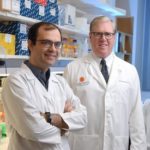 UTA ASTROPHYSICISTS ID POSSIBLE EARTH-LIKE PLANET
UTA ASTROPHYSICISTS ID POSSIBLE EARTH-LIKE PLANET

Suman Satyal [Photo Courtesy the UT Arlington]
There may be no place like home, but astrophysicists at the University of Texas at Arlington have predicted that an Earth-like plant may be spinning around in a star system 16 light years away.
The UTA team looked at the star system Gliese 832 for what are called “exoplanets” that might lie between the two currently known worlds in that system, and they discovered what might be an Earth-like planet at a distance ranging from 0.25 to 2 astronomical units from the system’s star.
“According to our calculations, this hypothetical alien world would probably have a mass between 1 to 15 Earth’s masses,” lead author Suman Satyal, UTA physics researcher, lecturer and laboratory supervisor, said. Co-authors on the paper are John Griffith, UTA undergraduate student and longtime UTA physics professor Zdzislaw Musielak.
Their work was published as “Dynamics of a probable Earth-like Plant in the GJ 832 System,” in The Astrophysical Journal.
BRAIN RESEARCHERS FOCUS ON CANNABIS USE

UT Dallas Associate Professor Francesca Filbey. [UT Dallas Photo]
In new research from the Center for BrainHealth at the University of Texas at Dallas, researchers say that levels of THC, the psychoactive ingredient in cannabis, correlate directly to changes in how the brain utilizes oxygen. THC creates a feeling of euphoria in people.
The team was led by Dr. Francesca Filbey, director of Cognitive Neuroscience Research in Addictive Disorders at the Center for BrainHealth. The researchers found that chronic cannabis users have higher cerebral blood flow, and extract more oxygen from brain blood flow than nonusers.
They said their research found that the rate at which the brain metabolizes oxygen was found to be higher in users as well.
Researchers analyzed differences in regional brain oxygenation in chronic cannabis users as they focused on how prolonged THC use might affect the brain.
STEM CELLS AND VITAMIN C FOCUS OF RESEARCH

Dr. Michalis Agathocleous (left) and Dr. Sean Morrison. [UT Southwestern Photo]
Researchers at the Children’s Medical Center Research Institute at UT Southwestern have found that stem cells soak up unusually high levels of Vitamin C, regulating their function and suppressing the development of leukemia.
Techniques developed during the research by Drs. Michalis Agathocieous and Sean Morrison allowed researchers to routinely measure metabolite levels in rare cell populations such as stem cells. Previously, that was very difficult to do because a large number of cells are needed for metabolic analysis. The study was published in Nature.
Researchers then were able to discover that every type of blood-forming cell in the bone marrow had distinct metabolic signatures. They discovered that stem cells take up high levels of ascorbate — Vitamin C.
The team then used mice to further their studies by striating controlling the ascorbate intake by the rodents and mimicking ascorbate levels seen in roughly 5 percent of healthy humans.
Researchers were surprised to find that stem cells actually gained function, but with increased instanced of leukemia. You can find more on this research here.
Dallas Innovates, every day
One quick signup, and you’ll be on the list.
View previous emails.

































